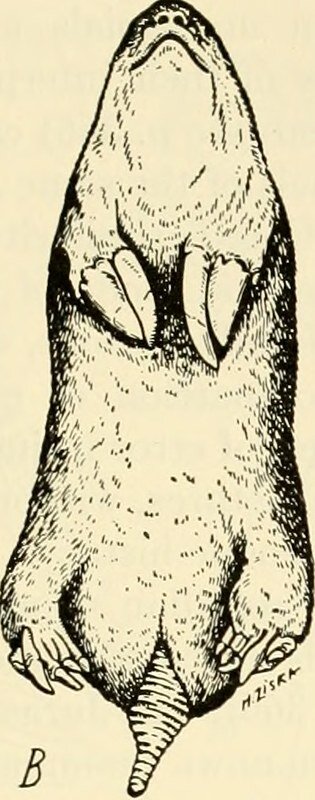Notoryctes typhlops
Southern Marsupial mole anatomy
Southern marsupial moles also known as the itjaritjari. The itjaritjari are an important ancestral creature for the Anangu of the Red Centre, and features in the Dreaming of several more Aboriginal groups. They are burrowing marsupials and adapted to living most of their time underground in the Central Australian desert. They come to the surface only on rare occasions probably after rains. They do not have permanent burrows and when they move through the sand or soil it is as if they are swimming through the soil.
Head, eyes and teeth:
Marsupial moles do not have functioning eyes and are blind. Their eyes have reduced to vestigial lenses that are found under the skin on the side of the head and lack a pupil. They have no external ears, just a pair of tiny holes hidden under thick hair. The head is cone-shaped, with a leathery shield over the muzzle.
They have no auricle, with the external ear canal buried under fur. Hearing is most likely through bone conduction from the jaw (mandible).
The teeth of the marsupial moles are degenerate and bear no resemblance to polyprotodont or diprotodont teeth. Their dental formula varies, but is usually somewhere near 4–3.1.2.43.1.3.4 × 2 = 42–44. The upper molar teeth are triangular and zalambdodont, i.e., resembling an inverted Greek letter lambda in occlusal view, and the lower molars appear to have lost their talonid basins.
Body:
The body is tubular, and the tail is a short, bald stub encased in leathery skin. They are between 12 and 16 centimetres (4.7–6.3 in) long, weigh 40 to 60 grams (1.4–2.1 oz), and are uniformly covered in fairly short, very fine pale cream to white hair with an iridescent golden sheen.
Pouch:
Marsupial moles have a true pouch that is small and well developed. The pouch faces background like wombat pouches. This is an adaptation to stop soil or sand coming into the pouch and the pouch filling with soil/sand. The pouch contains two teats and usually carried one pouch young at a time.
Limbs:
The limbs are very short, with reduced digits. The forefeet have two greatly enlarged, spade shaped, flat claws on the third and fourth digits, which are used to excavate soil in front of the animal. These claws resemble paddles and adapted for digging. The hindfeet are flattened, and bear three small claws; these feet are used to push soil behind the animal as it digs. Epipubic bones are present but small and as in some other fossorial mammals (e.g., armadillos), the last five cervical vertebrae are fused to give the head greater rigidity during digging. The animal swims through the soil and doesn't leave behind any permanent burrow.
Ventral view of marsupial mole. Image from page 369 of "Mammals of other lands;" (1917) by Cornish, C. J. (Charles John), 1858-1906
This image above is of the Ventral view of marsupial mole. The following is the description from page 369 by Cornish (1917): “Notice the abnormal size of the third and fourth toes of the fore limbs, and their peculiar scoop-like shape .The colour of the pouched mole is for the most part light fawn, varying in parts to golden yellow. One of its most conspicuous features, as illustrated in the accompanying photographs, is the abnormal size of the third and fourth toes of the fore limbs, their peculiar scoop-like character proving of eminent service to the animal in its customary sand-burrowing habits.


